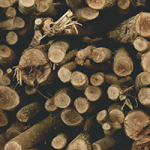We’re all aware that burning logs is a much more environmentally friendly way to heat our homes when compared with using other fossil fuels, such as gas, oil or coal. However, chances are that you’re probably not quite so informed about the best type of wood to burn in your log burner. If you’ve ever wondered which firewood you should buy for your wood burning stove, here’s the lowdown on the differences between kiln dried and barn dried wood.
All wood contains moisture in the form of water. The amount of moisture content is the key to quality firewood; less moisture equals better firewood while more moisture equals a slower burn, more smoke and more pollutants released into the air, plus more deposits on your stove and flue. Therefore, not surprisingly, wood burning stove manufacturers prefer you to burn wood with a low moisture content.
What are kiln dried logs and why should you burn them?
Kiln dried wood gives you the kind of fire you’ve always dreamed of – fast, hot and beautiful. It produces the most efficient type of firewood logs, thanks to their low moisture content, which is usually less than 20%. This means that as there’s less moisture, less energy is required to burn off this moisture, leaving more energy to be converted into heat. Added to this, they’re easy to set alight and they give off that all-important roaring flame.
One big advantage of kiln dried logs is that because they burn hotter and more efficiently, you actually need fewer logs to achieve the same output as barn dried logs or green wood. Additionally, there’s no extra drying time required, which means that you can add them to your fire as soon as you get them. Furthermore, as logs that have been kiln dried burn at higher temperatures, any water and sap retained in the wood are burned off, thus reducing the likelihood of it leaving a residue of tar on the inside of your stove, which can ultimately lead to it becoming less efficient.
What about barn dried logs?
Barn dried or seasoned logs are, as their name suggests, allowed to dry out in a barn, usually until they contain less than 30% moisture. While they are excellent for use in wood burning stoves and can be used immediately, for best performance, it’s usually recommended that barn dried firewood logs are allowed an additional drying time of up to four weeks before they’re used on a fire. During the drying process, they are stored in slatted crates to allow for the free movement of wind and air through the logs to dry and season the wood. It’s a centuries old technique that is both efficient and effective.
As you can see, both kiln dried and barn dried woods are the preferred source of fuel for log burners if you want to keep your log burner, and your chimney, cleaner for longer.





It was really nice how you mentioned that kiln dried wood usually have 20% less moisture content than other types of wood and so they provide fast, hot, and beautiful fire. That’s actually a pretty good thing to know. I honestly don’t understand what a kiln-dried wood is and what it can do for me. That’s why I find it weird that my brother was always asking me to order this type of log. Now I know that it’s used for making fire. Thanks! I know a few more things now.